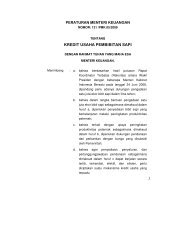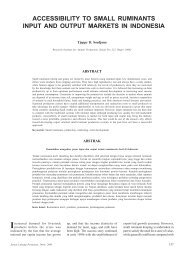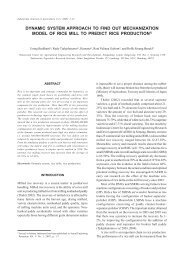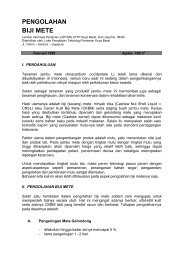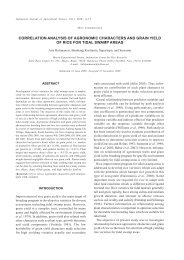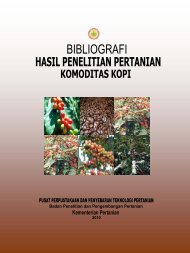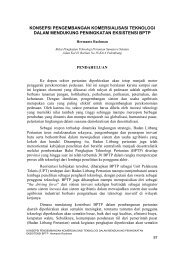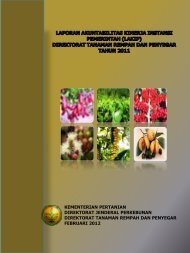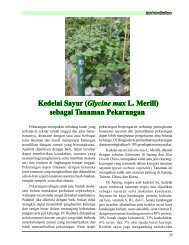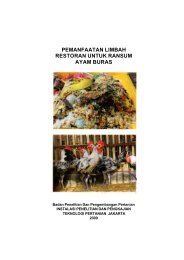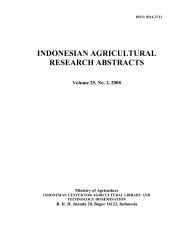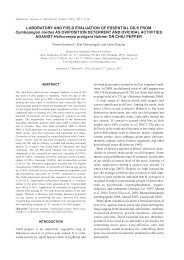major issues and challenges for improving the marketing
major issues and challenges for improving the marketing
major issues and challenges for improving the marketing
Create successful ePaper yourself
Turn your PDF publications into a flip-book with our unique Google optimized e-Paper software.
fresh <strong>and</strong> frozen fruits increase sharply in Japan. Fruit imports are mostly in frozen<strong>for</strong>m due to strict requirements <strong>for</strong> quarantine <strong>and</strong> food safety law. Indonesianexport share in Japan is still very low.In 1992 Indonesia was <strong>the</strong> leading shrimp exporter to Japan with a marketshare of 21 percent. However, dem<strong>and</strong> <strong>for</strong> frozen shrimp is projected to decreasein <strong>the</strong> next 3 years. According to Sanwa Research Institute (2000), frozen shrimpmarket is saturating, <strong>and</strong> dem<strong>and</strong> <strong>for</strong> processed products such as hot <strong>and</strong> spicy fishtend to increase especially <strong>for</strong> youngsters. Again, market opportunity is widelyopen but in a different <strong>for</strong>m, much different than it was 10 years ago.How about United States? Fish import into USA is predicted to increase<strong>for</strong> <strong>the</strong> next 3 years. By value, US shrimp import was 4.38 percent in <strong>the</strong> last 5years. Main supplier was Thail<strong>and</strong> with 34% share, while Indonesia's share wasonly 5%. Import bill of USA <strong>for</strong> shrimp was US $ 3.1 billions in 1998. For tuna,USA is <strong>the</strong> second largest importer after Japan with annual import rangingbetween 240,000-250,000 tons. Indonesian tuna export was 14,000 tons in 1998.The leading supplier is Thail<strong>and</strong> followed by <strong>the</strong> Philippines.Currently, USA tends to import more tropical products because of strongdollar relative to Asian currencies. Indonesia <strong>for</strong> instance, is <strong>the</strong> second largestexporter of cocoa beans to <strong>the</strong> USA after Ivory Coast. The problem with <strong>the</strong> USAmarket is that it tends to impose more strict requirements than that of internationalst<strong>and</strong>ard such as Codex Alimentarius- a condition legalized by <strong>the</strong> World TradeOrganization (WTO). Many Indonesian export products are still subject todetention imposed by <strong>the</strong> USA such as shrimp, tuna, fish fillet, cocoa beans,mushroom <strong>and</strong> can pineapple.The Uruguay Round Agreement will open products markets in <strong>the</strong>developed countries applying high protection <strong>for</strong> <strong>the</strong>ir agriculture practicesfacilitated by <strong>the</strong> "minimum access" that should be applied. This will be ano<strong>the</strong>rchallenge <strong>for</strong> developing countries to enhance <strong>the</strong>ir share in <strong>the</strong> global market ofagricultural products. However, o<strong>the</strong>r constraints may arise especially in <strong>the</strong> <strong>for</strong>mof disguise export subsidies <strong>and</strong> domestic supports which so far have been heavilypracticed by some countries (developed countries <strong>the</strong> most).ASEAN countries have not traditionally exported high valued foodcommodities, but Thail<strong>and</strong> has become a successful exporter processed fruits,vegetables <strong>and</strong> fish product. It also exports poultry products <strong>and</strong> leads in <strong>the</strong>export of fresh tropical fruits.To accommodate this opportunity, a strong <strong>and</strong> effective food processing<strong>and</strong> o<strong>the</strong>r agro-based industries sectors are considered to be important <strong>for</strong>diversification <strong>and</strong> commercialization of agriculture, <strong>improving</strong> rural income <strong>and</strong>employment, value addition <strong>and</strong> generation of surplus <strong>for</strong> export, reducing wasteof perishable products, as well as foster rural industrialization. The governmentshould provide massive thrusts <strong>and</strong> act as a catalyst <strong>for</strong> getting investments intoagribusiness including food processing sector, encouraging export <strong>and</strong> creating aAKP. Volume 2 No. 1, Maret 2004 : 25-3628



